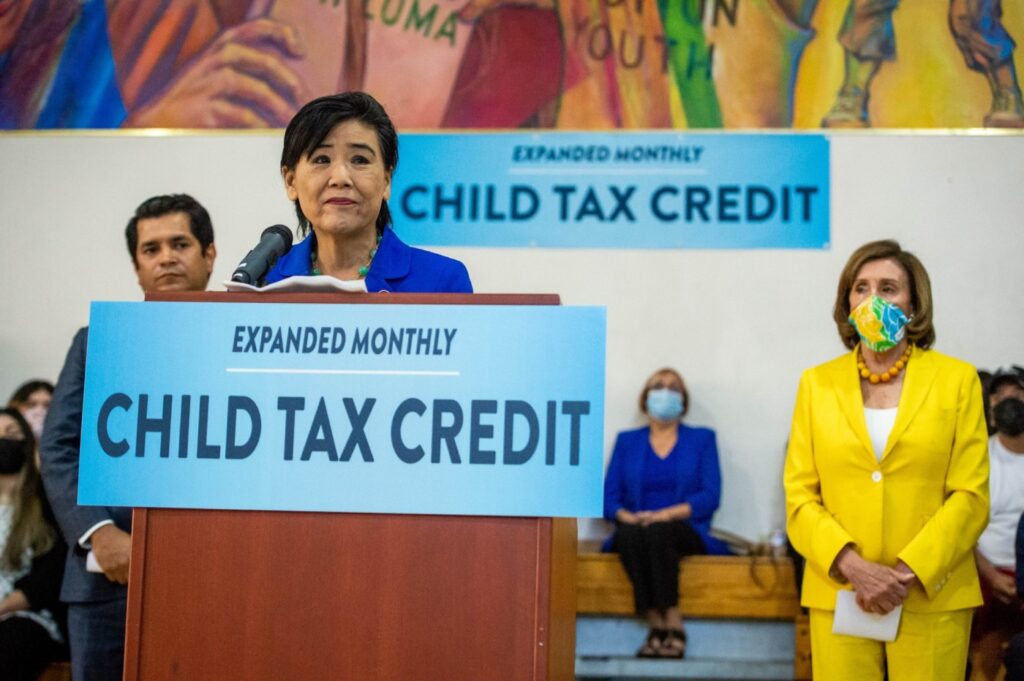
Perhaps the most important anti-poverty, counter-inflationary provision amidst all the new ideas in the president’s Build Back Better agenda is its reinvestment in an old policy that – plain and simply – works. The extension of an enhanced child tax credit (CTC) through 2022 will help lift millions of American families out of poverty, ease the burdens of rising costs, and expand opportunities for the middle class.
First passed in 1997, the CTC is a benefit granted to American parents for each of their qualifying dependents. Reformed in 2021, the new CTC contained a significant increase from the pre-pandemic maximum of $2,000 per child under 17 to $3,600 per child under 6-years-old and $3,000 per-child for kids ages 6 to 17. It was made fully refundable, meaning the full amount was distributed to all families regardless of income. Additionally, for this one expansion year, the IRS was given the flexibility to distribute the credit via advance payment — on a monthly basis — instead of paying households with one big amount at tax time.
The results of these changes have been nothing short of remarkable for working class families. In less than a year, the monthly CTC payments have shown meaningful progress on reducing child poverty and hunger, promoting financial security and responsible spending, and protecting families from inflation. And while there is no denying that the increased size and refundability aspects of the “new CTC” have been essential to reducing poverty, the importance of distributing the credit in monthly installments cannot be overstated, enabling better budgeting and planning, and helping families adjust to rising costs and take responsibility for their own well-being.
Indeed, several recent data points strongly support these findings:
According to a survey conducted by the Social Policy Institute at Washington University in St. Louis, three in four parents in this survey preferred monthly payments over annual refunds.
In the same survey, families reported using monthly CTC funds on food (51 percent), paying essential bills (36 percent), as well as clothing and other essential products for their children (30 percent). These are monthly expenses, with rising costs.
Monthly CTC payments have been associated with a 25% decline in food insufficiency among low-income families with children, according to researchers at the Columbia University Center on Poverty and Social Policy.
Nearly 17% of those with at least one child under 5 years old reported spending their monthly CTC allotment on child care services, according to the Census Bureau’s Household Pulse Survey. This helps families return to work.
Research also demonstrates that the monthly nature of these payments can reduce household expenditures on unhealthy purchases such as drugs and alcohol, by reducing the physically and emotionally destructive stress of poverty.
Beyond their direct importance to the families that receive it, the availability of monthly CTC payments has also provided a consistent flow of customers to small businesses and local economies that is more beneficial, and sustainable, than a yearly lump-sum approach.
Related Articles
One-party rule is toxic everywhere, including California
Enrollment declines squeeze local school finances
Biden falling approval isn’t a real surprise
Is press too hard on President Joe Biden?: Letters
Liberal economists undermine the premise of Build Back Better
Indeed, the Niskanen Center estimates that the CTC monthly payments will boost consumer spending by $27 billion, generate $1.9 billion in state and local sales tax revenue, and support more than 500,000 full time jobs at the median wage. It makes sense that small and local businesses stand to benefit to a greater degree from the routine and predictable spending decisions made available by monthly CTC payments, whereas the purchase of luxury goods or unhealthy vices, such as what may be spurred by once-annual lump sum payments, will be less helpful to local economies and would further aggravate inflation.
With the expanded CTC set to expire at the end of the year, and with costs still rising as our economy emerges from a pandemic, Congress must coalesce behind an extension of this vital financial support for working class families as part of the Build Back Better Act. We can further build upon this progress by ensuring that CTC payments will continue to be made payable in monthly installments two months from now. In the long-term, a reversion to lump sum CTC at tax time could leave millions of working-class families, and their children, at risk of financial instability, unpredictable inflation, and economic uncertainty.
To build upon the progress we’ve already made, we owe it to these families to ensure that the structure of the current CTC , with monthly payments, remains in place.
Matt Zwolinski is the director of the University of San Diego’s Center for Ethics, Economics, Public Policy and co-director of USD’s Institute for Law and Philosophy, and a member of Humanity Forward’s Bipartisan Advisory Council.
Leah Hamilton is an associate professor of social work at Appalachian State University, Senior Fellow at the Jain Family Institute, and Faculty Affiliate at the Social Policy Institute of Washington University in St. Louis, and a member of Humanity Forward’s Bipartisan Advisory Council.
